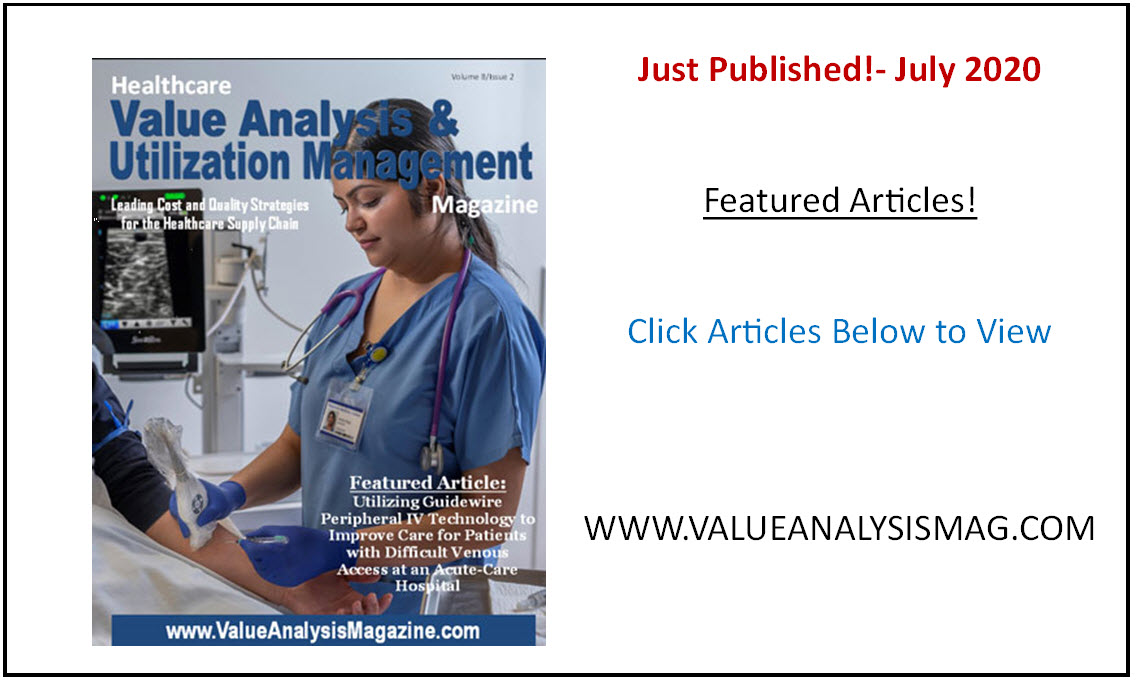James Russell, RN-BC, Value Analysis Facilitator, UF Health at Jacksonville
VCU Health System, Richmond, VA
The concept of Physician Preference Items (PPI) has been a mainstay in clinical value analysis for many years. It has dominated the Perioperative and Interventional worlds as often the largest expense in the acquisition of new products and technologies. With the progression toward evidence-based clinical practice (a hallmark of any ANCC Magnet organization), the shift toward patient-specific products might be inevitable. We can only hope!
I know of an organization that spent several million dollars on new Radiology equipment because they had recruited a new Medical Director of Radiology and he liked Company A vs. Company B. A few short years later, this highly respected physician left the institution for another position and a new Medical Director was recruited. You can see where this is going. The facility spent millions replacing their perfectly fine equipment from Company A with brand new machines from Company B, because that was the new doctor’s preference. The not so funny thing is, this is not an uncommon story.
A frontier that value analysis would do well to climb into is physician recruitment. When a facility is recruiting a new Orthopedic Surgeon, the time to find out her preferences for orthopedic implants is not when she schedules her first case! Finding out her preferences on the front end can help avoid chaos on the back end. There may be things that she’s flexible with (certain types of external fixation may be generic to her and she may not care which vendor the hospital uses). There may be things she believes strongly in. The time for her to present her preferences to the perioperative value analysis team is before she’s ready to do surgery. That team may require her to bring evidence to support her assertion that Vendor X is clinically superior to Vendor Y. She may be right! New ideas aren’t automatically wrong, just because they didn’t originate with the “Old Guard.” The facility may want to go out for bid in this category, based upon her evidence. I heard a wonderful analogy to the introduction of new ideas described as watching the immune system of the facility’s culture attack like the idea was an unwelcome pathogen. Sometimes, new ideas are beneficial.
All too often, however, new products are brought in simply because a physician requires it. If the facility’s goal is conflict avoidance, getting the MD what he wants is an easy way to accomplish this. Most facilities don’t have an endless supply of money to provide every doctor with exactly what he or she wants. Compromises must be made on both sides. This is where evidence becomes the perfect decision-making tool. It takes opinions (emotion) completely out of the picture and lets data, evidence, math, and logic determine the appropriate course of action. This process is best done with a physician’s peer group. How many times has a doctor expressed that Brand C is the best thing for his patients and then switched his tune to Brand D when the vendor representative changes jobs? This physician’s colleagues can call him on this in ways that are difficult, but not impossible, for the Value Analysis Facilitator to do.
Another appropriate step to take is to determine if a physician’s allegiance to a certain manufacturer is based upon the superiority of the company’s products or other less transparent factors. The Centers for Medicare and Medicaid Services (CMS) has published data related to the Open Payments portion of the Patient Protection and Affordable Care Act of 2010. This data, open to the public, allows individuals to search for payments made by manufacturers to both physicians and teaching hospitals. It is entirely appropriate to see if our new Orthopedist was paid $10,000 in speaking fees by Vendor X last year. That doesn’t mean she’s done anything wrong or that she can’t champion this vendor to be brought into the hospital’s formulary. It does, however, bear some scrutiny. Did she disclose this information or did the team have to find out on their own? Was she involved in the creation of any of the company’s products? Could there be Stark Law violation concerns if she gets royalties and champions the product? This is different than Open Payments and most doctors understand it better. The concept, however, is similar.
I once had a physician make his case by telling me, “The reason I want this thing is that I know so much about it. I’ve spent years speaking about it and defending it to my colleagues. I’ve got reams of evidence and peer-reviewed independent studies that show its superiority.” My response? Perfect! Then you won’t have any trouble convincing the value analysis team of that, because your opinion is based on evidence, not how much money the company gives you.
Again, evidence-based practice makes the perfect lightning rod. If the proposed product can stand up to the test of evidence, it is not really a Physician Preference Item. It is what’s best for the facility’s patients. That’s a much more appropriate, and defensible, position. Suppose your new orthopedic surgeon wins her case and the facility converts a significant portion of its marketshare to Vendor X. This could be a multi-million dollar decision. What if Vendor Y objects (perhaps even publicly), saying that the decision was made because Vendor X gives the new doctor large fees for speaking engagements? As long as evidence is on your side, you have a logical basis for the decision you made.
The days of being afraid that a physician will be offended by these ideas are over. The checks and balances of evidence and open payments are there to protect the MD as well as the facility. However, an institution must have the organizational will to take on those physicians who simply want what they want, when they want it. Somebody has to be willing to say no and risk the backlash. Suppose your committee tells the physician they haven’t made a compelling case as to why the hospital should spend more money for Vendor X when no evidence exists that it’s better for patients. What happens if he/she runs to senior leadership and threatens to leave the facility if she doesn’t get his/her way? Orthopedic surgery is a significant portion of many facilities’ revenue. Is senior leadership willing to back the committee’s decision, or will they cave to the pressure of a temper tantrum by a powerful practitioner? If you don’t know the answer to this question…don’t say no until you do! You may find yourself out on a limb all by yourself.
Jim Russell is a Value Analysis Facilitator UF Health at Jacksonville and has more than 25 years of nursing experience, specializing in critical care and psychiatry. He has been a Staff Nurse, Charge Nurse, Clinical Coordinator, Nurse Manager, Director, and Chief Nursing Officer. He worked for many years in the for-profit community healthcare sector and also has several Academic Medical Centers on his resume. Jim sat for 5 years on the Nursing Advisory Board for a HealthTrust, performing Value Analysis for nursing related products and represented more than 70 hospitals. He is currently on several Advisory Councils and Special Interest Groups for UHC and Novation. When not at work, he can be found rolling around with his hyperactive rescue Husky. You can contact Russell with your questions or comments at James.Russell@jax.ufl.edu





